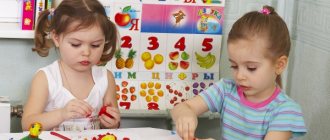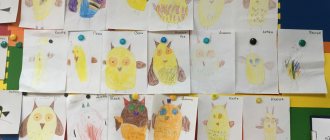Summary of GCD for modeling in the preparatory group “Furniture for a doll’s house”
Ekaterina Shchirova
Summary of GCD for modeling in the preparatory group “Furniture for a doll’s house”
Summary of GCD for modeling in the preparatory group “Furniture for a doll’s house”
Form of organization:
Group.
Type of lesson:
Artistic and aesthetic (modeling).
Target:
Develop plasticine modeling skills.
Tasks:
1. Continue teaching children to sculpt doll furniture, create objects of different sizes and colors; develop fine motor skills, interest in productive activities, and creative imagination.
2. Learn to select relative and qualitative adjectives; activate the names of pieces of furniture in children’s speech; consolidate the ability to identify a preposition audibly and correctly correlate it with an action.
3. Teach children to negotiate with each other and adequately evaluate their work.
Material:
plasticine, stacks, plates for modeling, napkins, dollhouse, photographs of furniture.
Progress of the lesson
Educator:
We're in trouble; we've lost our doll furniture. Guys, let's make new furniture for our dollhouses. Are you willing to help?
Children:
Yes.
Educator
: Pay attention to the house. It is partially filled with furniture, some rooms are empty.
Educator:
What kind of room do you think is on the second floor?
Children:
Bedroom.
Educator:
- How did you guess?
Children:
There is a bed there.
Educator:
What rooms can be located on the ground floor? Do you know what rooms (living room, kitchen) are already written here?
Educator:
List the pieces of furniture that can be in the living room? (sofa, armchair, coffee table)
- And in the kitchen? (table, stool)
Educator:
- Guys, but don’t forget that the house is a toy and the furniture in it is also a toy. Think and tell me, what can we quickly make doll furniture from? (made of plasticine).
But before we start working, let’s set up our fingers so that they work hard so that the furniture is durable, strong, beautiful, and neat.
Let's play.
Physical education minute:
This is a chair - they sit on it (the left palm in a fist is pressed against the right, fingers extended upward).
This is a table - people sit at it (the left hand is in a fist, the right open palm lies on top)
Here is a bed - they are lying on it (arms bent at the elbows in front of the chest, lying one on top of the other)
We put things away in the closet (imitation of folding things)
And we all work hard (the fingers of both hands walk on the knees)
Educator:
Guys, today you are working in threes - how is that? Look at each other and decide who will work with whom (in a whisper)
— The first three sculpt pieces of furniture for the kitchen.
- The second one is for the living room.
— Go to your workplaces.
- Now you must agree on what piece of furniture each of you will sculpt.
- Look at the pictures, pay attention to the characteristic features of the piece of furniture, what parts the object consists of. Now close your eyes and imagine this object.
Make the furniture not very large, and the sausage legs not too thin, otherwise they will not hold the seat and tabletop.
Bottom line
Educator:
Guys, what did we do today (Children's answers).
Today we worked hard and reviewed everything we learned about furniture.
Analysis of works
Look how beautiful the furniture turned out. I really liked all your works. It’s clear that you all tried very hard, you’re all great.
Summary of GCD for modeling in the middle group of preschool educational institutions
Summary of direct educational activities in artistic creativity (modeling) in the middle group
Topic: Houses of our city (Krasnoyarsk)
Goal: developing the ability to create objects from plasticine Tasks: Continue to teach using plasticine to create objects consisting of rectangular, square, triangular parts. To develop children's understanding that there are different houses in our city. Strengthen sculpting techniques (pulling, smoothing). Develop figurative ideas and imagination. Cultivate a positive attitude towards your hometown, feel pride in your city. Material: plasticine, modeling boards, stacks, cards depicting the Chapel and the Clock, paintings depicting houses in the city of Krasnoyarsk.
Progress of the lesson
Educator: What do we call the Motherland? (the place where we were born, live, go to kindergarten, where our mothers, fathers, friends live). “What do we call Motherland? The land where you and I live." Educator: There are a lot of big and small cities in the world. You and I live in the city of Krasnoyarsk. In our city there are many one-story and multi-story houses. There are pharmacies, shops, cinemas, etc. What do we see when we walk around the city of Krasnoyarsk? (shops, pharmacies, post office, houses) Educator: Let's clarify the appearance of the house, its parts: roof, windows, doors, their location. Imagine that you are architects. Who knows who architects are? Use your imagination and come up with your own buildings. Where do you start? Educator: you have cardboard on the tables, you need to draw with a simple pencil the house you want. And then take plasticine of any color and decorate your home. To do this, you need to roll up a sausage from plasticine and attach it to the walls of the house, windows, doors, the “sausages” can be of different colors, then your houses will be bright and beautiful. Educator : before we start work, we will divide into companies; there are cards on the tray. You need to choose one card and find a table on which there is a picture with the image of your card. (Cards: Chapel in the city of Krasnoyarsk, Tower clock on the Krasnoyarsk administration building). The children get to work . After finishing the work, look at all the crafts, display them, and admire how many houses there are - a whole city. Children talk about their craft. Praise for your efforts, feel proud of your favorite city. At the end of the lesson, pass a magic wand around the circle so that the children tell what they liked about the lesson.
We recommend watching:
Notes on educational activities in the middle group “Mushroom Glade” Notes on modeling from salt dough in the middle group of preschool educational institutions Notes on educational activities on modeling in the middle group. Tiger Summary of GCD on modeling for children of the middle group
Similar articles:
Lesson summary for the middle group: Safety at home
Summary of a lesson in kindergarten “Receiving guests.” Middle group
Lesson summary for the middle group on the topic: Properties of glass
Lesson in the middle group of kindergarten. Village courtyard
Summary of a lesson on cognitive development in the senior group. Rules of conduct in the circus



